中考英语语法考点总结——冠词(共28张PPT)
文档属性
| 名称 | 中考英语语法考点总结——冠词(共28张PPT) | 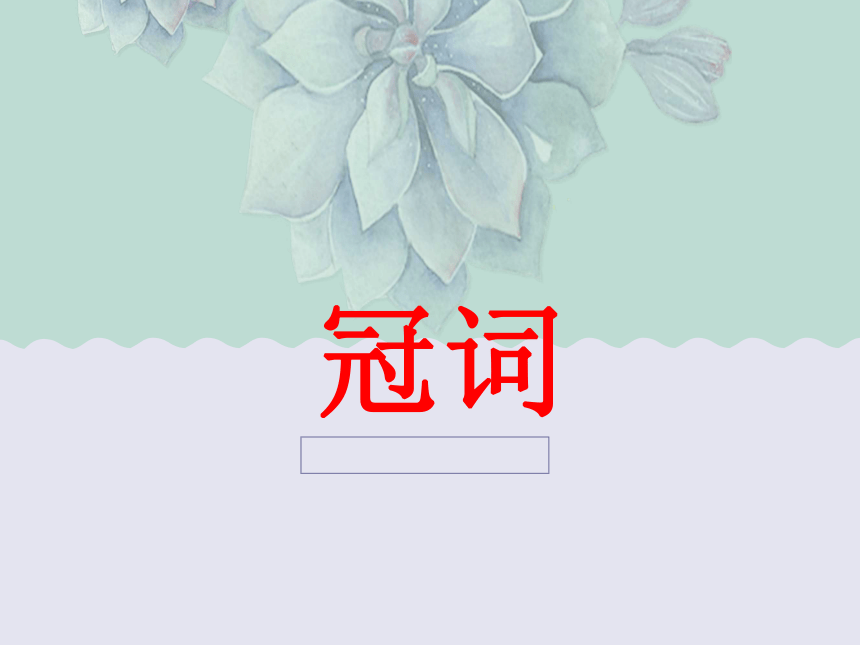 | |
| 格式 | ppt | ||
| 文件大小 | 2.8MB | ||
| 资源类型 | 试卷 | ||
| 版本资源 | 通用版 | ||
| 科目 | 英语 | ||
| 更新时间 | 2022-04-10 18:53:30 | ||
图片预览

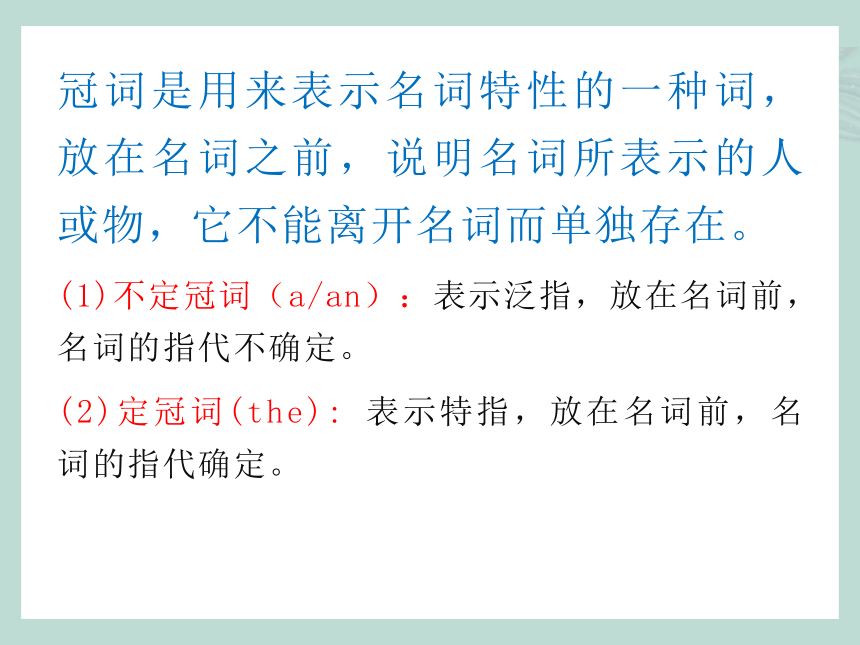
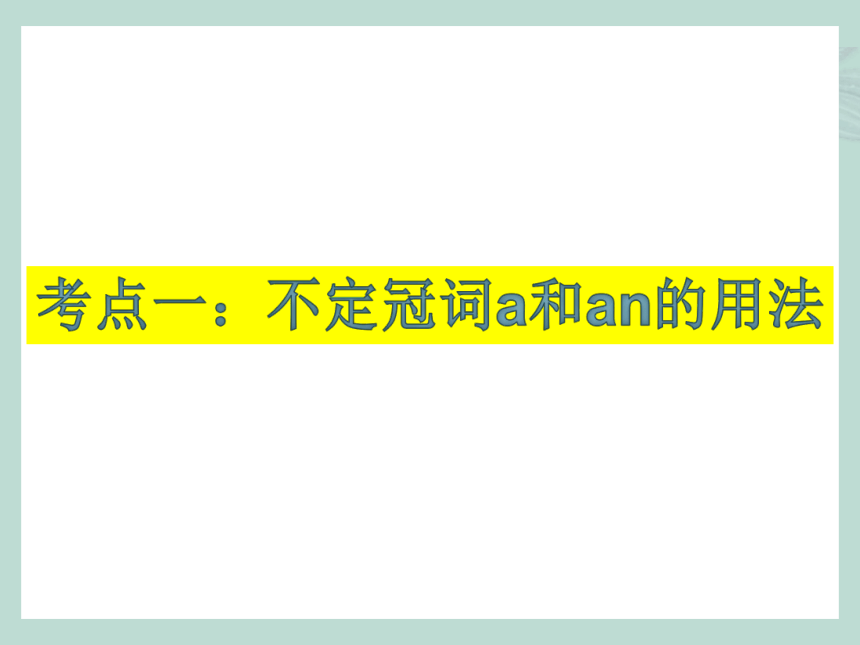
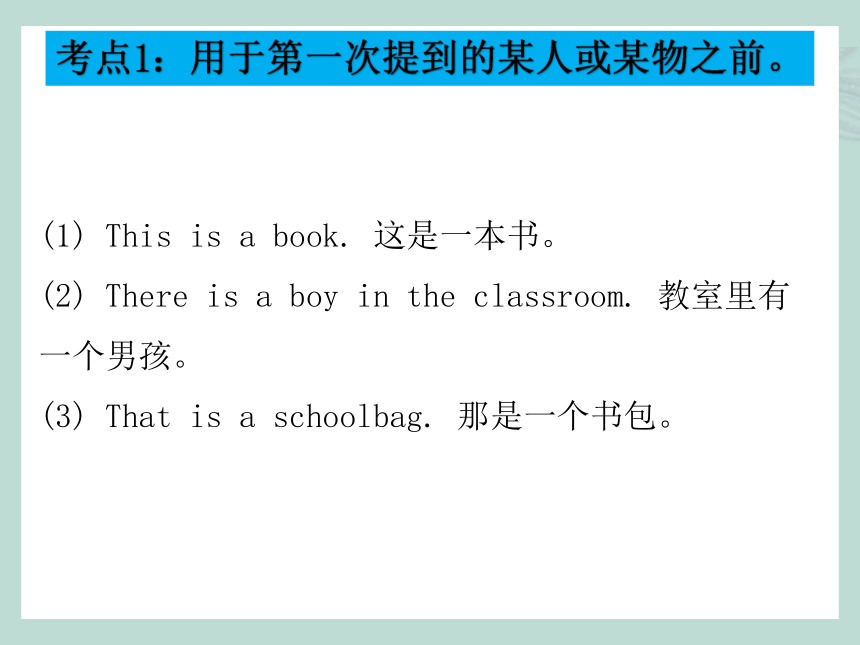
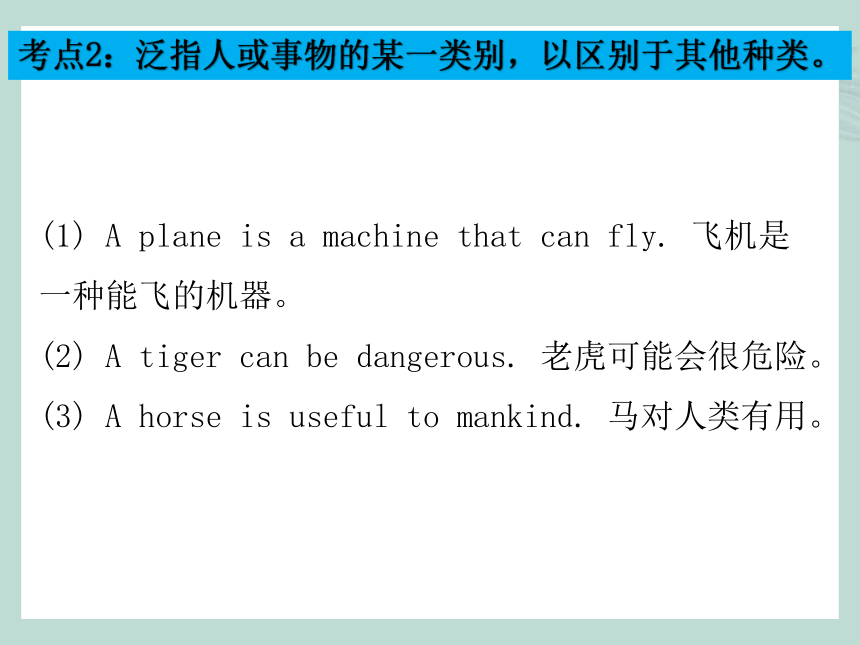

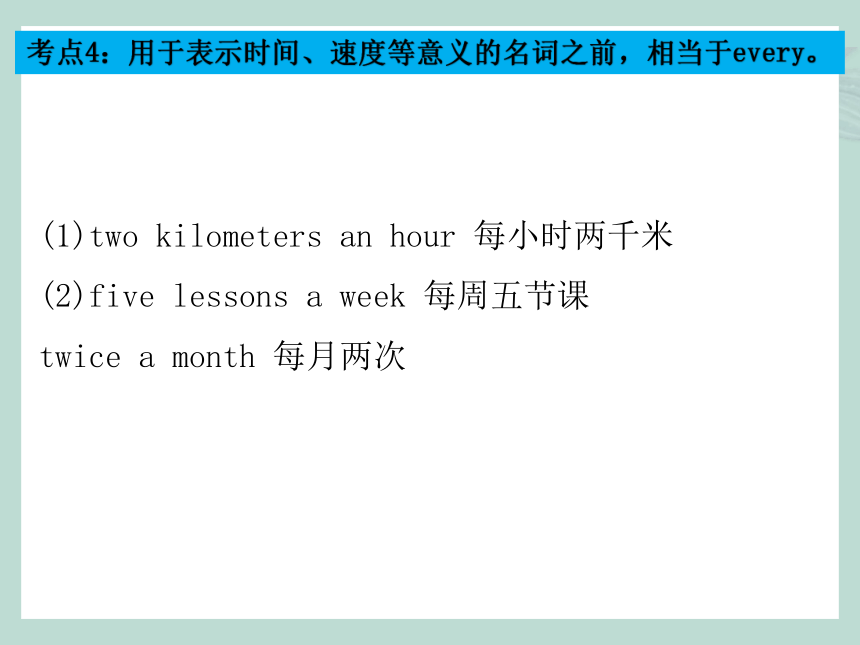
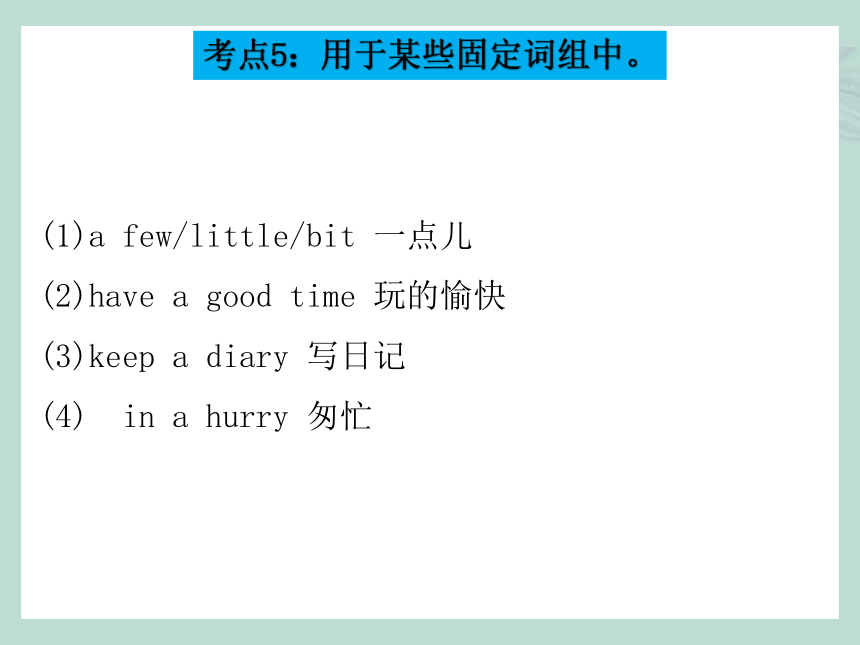
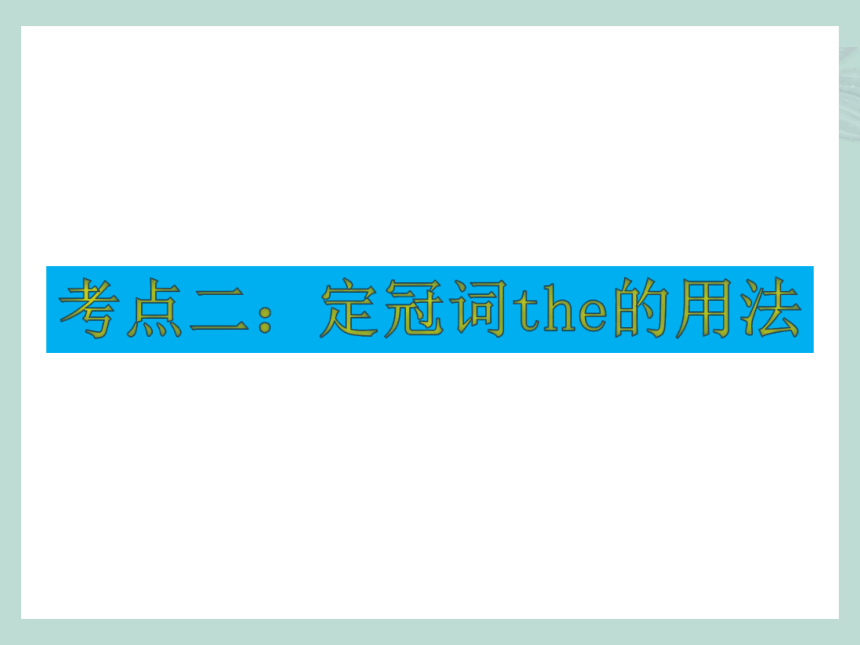
文档简介
(共28张PPT)
冠词
冠词是用来表示名词特性的一种词,放在名词之前,说明名词所表示的人或物,它不能离开名词而单独存在。
(1)不定冠词(a/an):表示泛指,放在名词前,名词的指代不确定。
(2)定冠词(the): 表示特指,放在名词前,名词的指代确定。
考点1:用于第一次提到的某人或某物之前。
(1) This is a book. 这是一本书。
(2) There is a boy in the classroom. 教室里有一个男孩。
(3) That is a schoolbag. 那是一个书包。
考点2:泛指人或事物的某一类别,以区别于其他种类。
(1) A plane is a machine that can fly. 飞机是一种能飞的机器。
(2) A tiger can be dangerous. 老虎可能会很危险。
(3) A horse is useful to mankind. 马对人类有用。
考点3:泛指某人或某物。
(1) A girl is waiting for you. 一个女孩正在等你。
(2) I have a beautiful bedroom. 我有个漂亮的卧室。
(3) It is an excellent movie. 这是一部很棒的电影。
考点4:用于表示时间、速度等意义的名词之前,相当于every。
(1)two kilometers an hour 每小时两千米
(2)five lessons a week 每周五节课
twice a month 每月两次
考点5:用于某些固定词组中。
(1)a few/little/bit 一点儿
(2)have a good time 玩的愉快
(3)keep a diary 写日记
(4) in a hurry 匆忙
考点1:表示双方都知道的人或事物。
(1)Give me the book, please.
(2)Don’t worry, if you can’t come to the party. I will save some cake for you.
Open the door, please.
考点2:表示特指的或上文已提到过的人或事物。
(第一次提到用“a或an”以后再次提到用“the”)
(1)Do you know the girl in red
(2)I have a book. The book is very interesting.
考点3:表示世界上独一无二的事物。
The earth moves around the sun.
The moon is bright at night.
The plane is flying in the sky.
There are about 200 countries in the world.
考点4:用在序数词,形容词最高级前面。
The first lesson is very easy.
She is the most careful student in our class.
He is the younger of the two boys.
考点5:用在姓氏的复数名词前表示一家人。
The Greens are watching TV now.
The Blacks are cleaning the house.
The Reads are having dinner.
考点6:用在由普通名词构成的专有名词前。
(1)the West Lake 西湖
(2)the Great Wall 长城
(3)the United States 美国
(4)the United Nations 联合国
考点7:与某些形容词连用表示一类人。
(1)the poor 穷人
(2)the rich 富人
(3)the old 老人
the sick 病人
考点7:用在表示方位或西洋乐器名称的名词之前。
Jilin is in the north of China.
The sun rises from the east.
I like playing the piano.
Lily is playing the violin.
考点1:专有名词,不可数名词前表示泛指。
China is a great country.
Mary lives in New York.
考点2:表示节日、日期、星期、月份、季节等词的前面
June 1st is Children’s Day.
Spring comes after winter.
That event happened in the spring of 1932.
考点3:三餐、球类及学科名词前用零冠词。
I went to school without having breakfast this morning.
He often plays basketball after school.
a用在以辅音音素开头的单词前,an用在以元音音素开头的单词前,判断一个单词是以元音音素开头还是以辅音音素开头,要根据其读音,而不是根据字母。
(1) He is an honest boy.
(2) There are sixty minutes in an hour.
(3) There is an “f” in the word “five”.
(1)在26个字母中,前面用an的字母有:A, E, F, H, I, L, M, N, O, R, S, X, 其他用a.
(2)以u开头的单词要注意区别:
an umbrella 一把伞
an unusual story 一个不同寻常的故事
an unhappy boy 一个不高兴的男孩
a university 一所大学
a unit 一个单元
a European country 一个欧洲国家
a useful book 一本有用的书
(1) go to school 上学(是学生)
go to the school 到学校去(不一定是学生)
(2) go to bed 就寝,上床睡觉
go to the bed 向床边走去,走到床前(不一定是去睡觉)
(3) in hospital 因病住院
in the hospital 在医院里(不一定是病人)
(4) at table 吃饭
at the table 在桌子旁
(5) at school 在上学
at the school 在学校里
(6) in class 在上课
in the class 在班级里
(7) in future 今后
in the future 将来
(8) in front of 在…(外部的)前面
in the front of 在…(内部的)前面
(9) next year 明年
the next year 第二年
(10) by sea 乘船
by the sea 在海边
(11) on bed (睡,病,躺)在床上
on the bed (某物)在床上
(12) on earth 究竟
on the earth 在地球上
THANK YOU
冠词
冠词是用来表示名词特性的一种词,放在名词之前,说明名词所表示的人或物,它不能离开名词而单独存在。
(1)不定冠词(a/an):表示泛指,放在名词前,名词的指代不确定。
(2)定冠词(the): 表示特指,放在名词前,名词的指代确定。
考点1:用于第一次提到的某人或某物之前。
(1) This is a book. 这是一本书。
(2) There is a boy in the classroom. 教室里有一个男孩。
(3) That is a schoolbag. 那是一个书包。
考点2:泛指人或事物的某一类别,以区别于其他种类。
(1) A plane is a machine that can fly. 飞机是一种能飞的机器。
(2) A tiger can be dangerous. 老虎可能会很危险。
(3) A horse is useful to mankind. 马对人类有用。
考点3:泛指某人或某物。
(1) A girl is waiting for you. 一个女孩正在等你。
(2) I have a beautiful bedroom. 我有个漂亮的卧室。
(3) It is an excellent movie. 这是一部很棒的电影。
考点4:用于表示时间、速度等意义的名词之前,相当于every。
(1)two kilometers an hour 每小时两千米
(2)five lessons a week 每周五节课
twice a month 每月两次
考点5:用于某些固定词组中。
(1)a few/little/bit 一点儿
(2)have a good time 玩的愉快
(3)keep a diary 写日记
(4) in a hurry 匆忙
考点1:表示双方都知道的人或事物。
(1)Give me the book, please.
(2)Don’t worry, if you can’t come to the party. I will save some cake for you.
Open the door, please.
考点2:表示特指的或上文已提到过的人或事物。
(第一次提到用“a或an”以后再次提到用“the”)
(1)Do you know the girl in red
(2)I have a book. The book is very interesting.
考点3:表示世界上独一无二的事物。
The earth moves around the sun.
The moon is bright at night.
The plane is flying in the sky.
There are about 200 countries in the world.
考点4:用在序数词,形容词最高级前面。
The first lesson is very easy.
She is the most careful student in our class.
He is the younger of the two boys.
考点5:用在姓氏的复数名词前表示一家人。
The Greens are watching TV now.
The Blacks are cleaning the house.
The Reads are having dinner.
考点6:用在由普通名词构成的专有名词前。
(1)the West Lake 西湖
(2)the Great Wall 长城
(3)the United States 美国
(4)the United Nations 联合国
考点7:与某些形容词连用表示一类人。
(1)the poor 穷人
(2)the rich 富人
(3)the old 老人
the sick 病人
考点7:用在表示方位或西洋乐器名称的名词之前。
Jilin is in the north of China.
The sun rises from the east.
I like playing the piano.
Lily is playing the violin.
考点1:专有名词,不可数名词前表示泛指。
China is a great country.
Mary lives in New York.
考点2:表示节日、日期、星期、月份、季节等词的前面
June 1st is Children’s Day.
Spring comes after winter.
That event happened in the spring of 1932.
考点3:三餐、球类及学科名词前用零冠词。
I went to school without having breakfast this morning.
He often plays basketball after school.
a用在以辅音音素开头的单词前,an用在以元音音素开头的单词前,判断一个单词是以元音音素开头还是以辅音音素开头,要根据其读音,而不是根据字母。
(1) He is an honest boy.
(2) There are sixty minutes in an hour.
(3) There is an “f” in the word “five”.
(1)在26个字母中,前面用an的字母有:A, E, F, H, I, L, M, N, O, R, S, X, 其他用a.
(2)以u开头的单词要注意区别:
an umbrella 一把伞
an unusual story 一个不同寻常的故事
an unhappy boy 一个不高兴的男孩
a university 一所大学
a unit 一个单元
a European country 一个欧洲国家
a useful book 一本有用的书
(1) go to school 上学(是学生)
go to the school 到学校去(不一定是学生)
(2) go to bed 就寝,上床睡觉
go to the bed 向床边走去,走到床前(不一定是去睡觉)
(3) in hospital 因病住院
in the hospital 在医院里(不一定是病人)
(4) at table 吃饭
at the table 在桌子旁
(5) at school 在上学
at the school 在学校里
(6) in class 在上课
in the class 在班级里
(7) in future 今后
in the future 将来
(8) in front of 在…(外部的)前面
in the front of 在…(内部的)前面
(9) next year 明年
the next year 第二年
(10) by sea 乘船
by the sea 在海边
(11) on bed (睡,病,躺)在床上
on the bed (某物)在床上
(12) on earth 究竟
on the earth 在地球上
THANK YOU
同课章节目录
- 词法
- 名词
- 动词和动词短语
- 动词语态
- 动词时态
- 助动词和情态动词
- 非谓语动词
- 冠词
- 代词
- 数词和量词
- 形容词副词及其比较等级
- 介词和介词短语
- 连词和感叹词
- 构词法
- 相似、相近词比较
- 句法
- 陈述句
- 一般疑问句和否定疑问句
- 特殊疑问句及选择疑问句
- 反意疑问句
- 存在句(There be句型)
- 宾语从句
- 定语从句
- 状语从句
- 主谓一致问题
- 简单句
- 并列句
- 复合句
- 主谓一致
- 主、表语从句
- 名词性从句
- 直接引语和间接引语
- 虚拟语气
- 感叹句
- 强调句
- 倒装句
- 祈使句
- 句子的成分
- 句子的分类
- 题型专区
- 单项选择部分
- 易错题
- 完形填空
- 阅读理解
- 词汇练习
- 听说训练
- 句型转换
- 补全对话
- 短文改错
- 翻译
- 书面表达
- 任务型阅读
- 语法填空
- 其他资料
